Business Ethics: Affirmative Action, Diversity, and Ethics
VerifiedAdded on 2022/10/02
|10
|2633
|19
Report
AI Summary
This report delves into the complexities of affirmative action within the realm of business ethics. It explores the appropriateness of affirmative action in achieving diversity, particularly focusing on its application in the private sector and the targeting of gender as a primary focus. The report examines arguments for and against affirmative action, referencing relevant literature and ethical theories like Utilitarianism and the ethics of duty. It analyzes whether affirmative action is ethically sound, considering its implications for promoting equal opportunities and addressing past discrimination. The report includes a discussion of the legal and practical aspects of affirmative action, referencing case studies and academic research to support its claims. The paper concludes with a discussion of the ethical implications of affirmative action, offering a nuanced perspective on its role in fostering a more inclusive and equitable workplace.
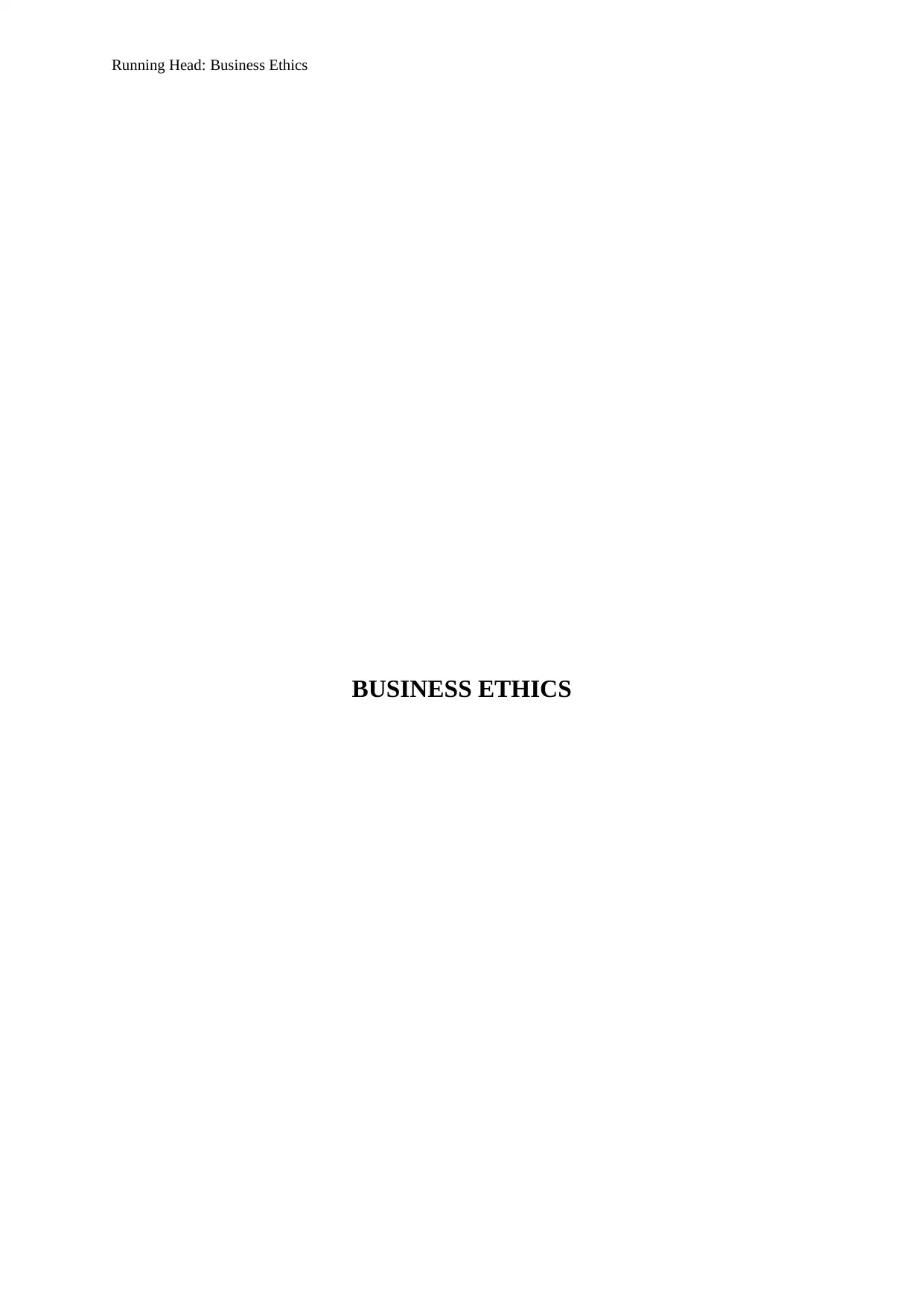
Running Head: Business Ethics
BUSINESS ETHICS
BUSINESS ETHICS
Paraphrase This Document
Need a fresh take? Get an instant paraphrase of this document with our AI Paraphraser
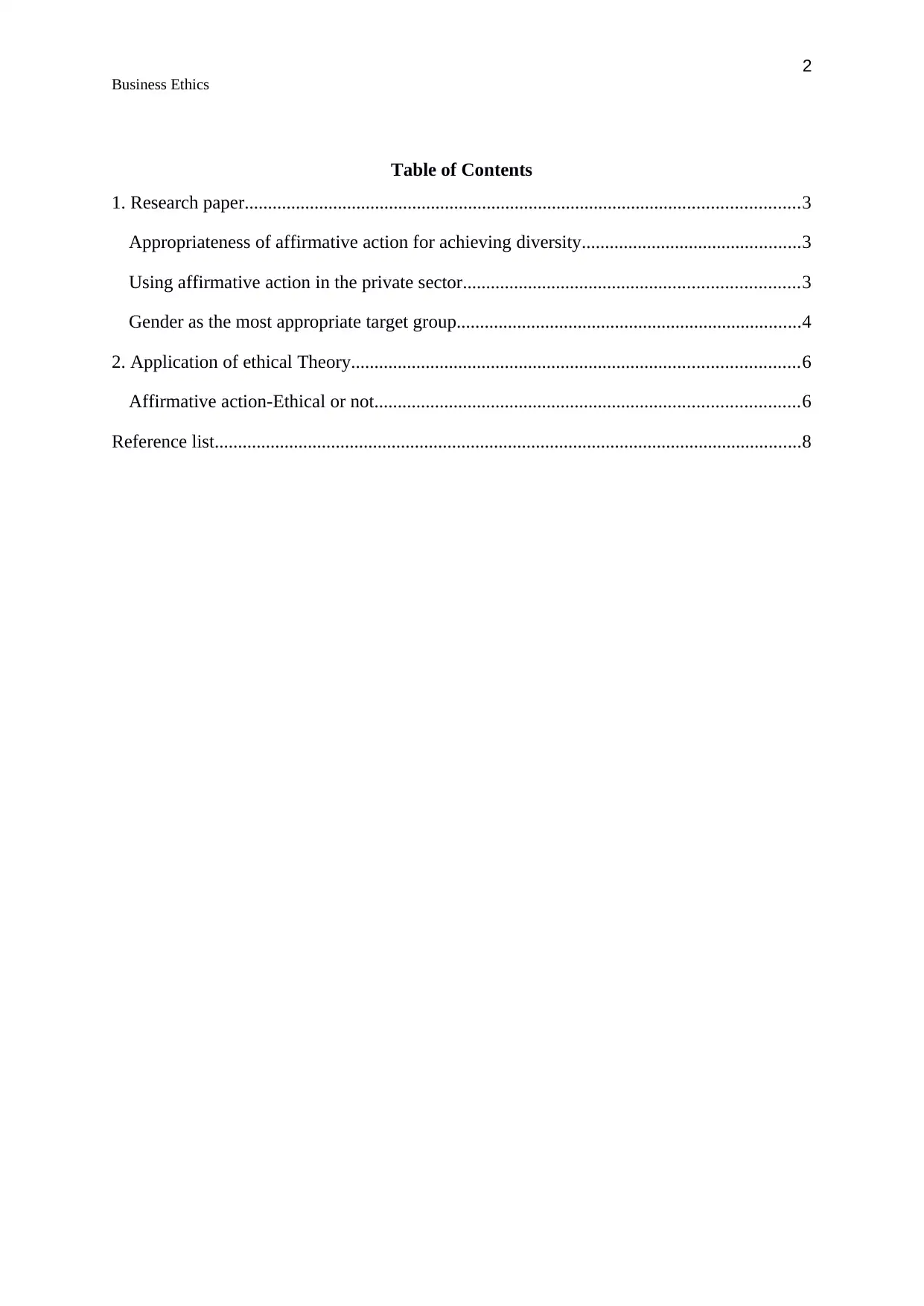
2
Business Ethics
Table of Contents
1. Research paper.......................................................................................................................3
Appropriateness of affirmative action for achieving diversity...............................................3
Using affirmative action in the private sector........................................................................3
Gender as the most appropriate target group..........................................................................4
2. Application of ethical Theory................................................................................................6
Affirmative action-Ethical or not...........................................................................................6
Reference list..............................................................................................................................8
Business Ethics
Table of Contents
1. Research paper.......................................................................................................................3
Appropriateness of affirmative action for achieving diversity...............................................3
Using affirmative action in the private sector........................................................................3
Gender as the most appropriate target group..........................................................................4
2. Application of ethical Theory................................................................................................6
Affirmative action-Ethical or not...........................................................................................6
Reference list..............................................................................................................................8
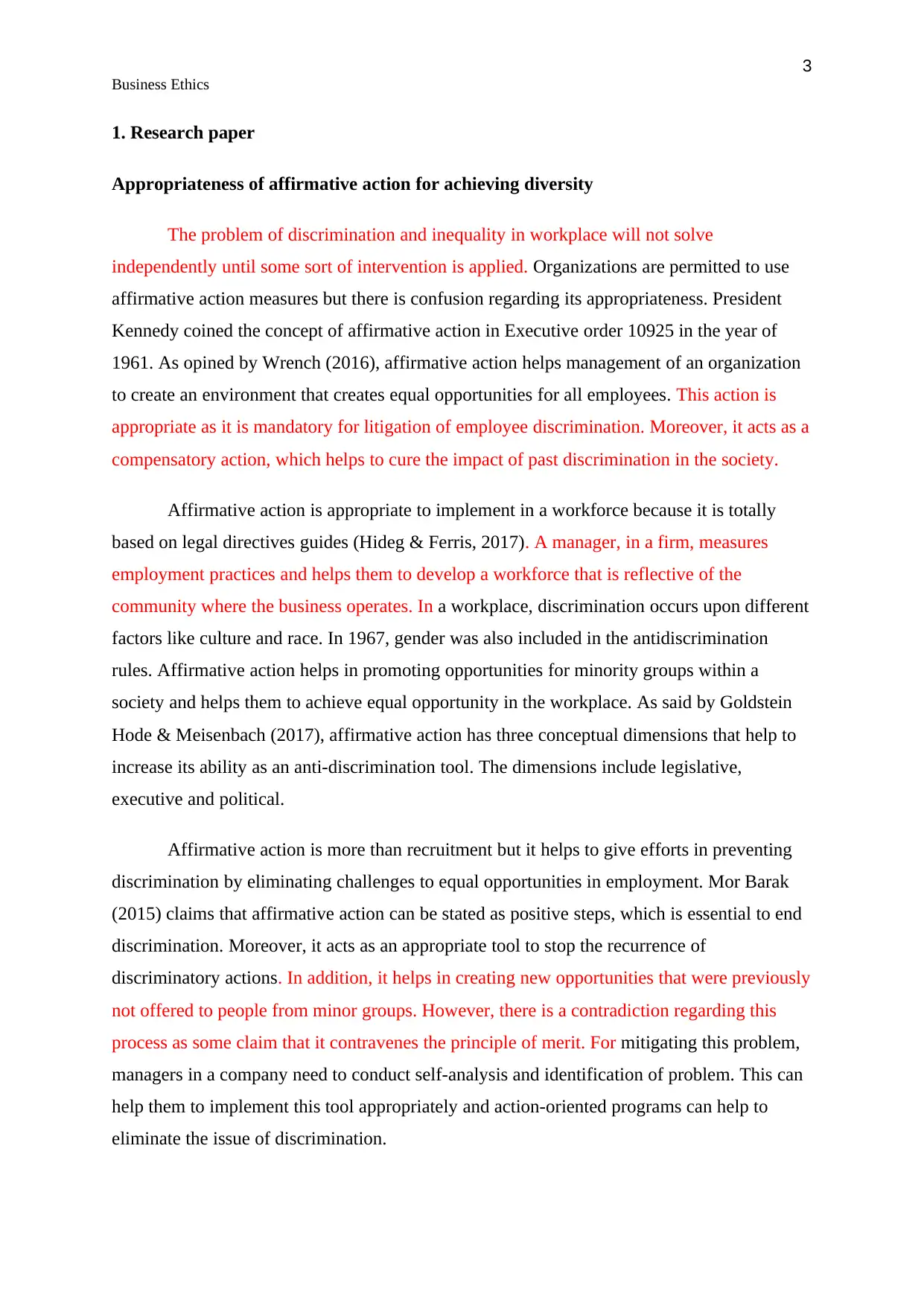
3
Business Ethics
1. Research paper
Appropriateness of affirmative action for achieving diversity
The problem of discrimination and inequality in workplace will not solve
independently until some sort of intervention is applied. Organizations are permitted to use
affirmative action measures but there is confusion regarding its appropriateness. President
Kennedy coined the concept of affirmative action in Executive order 10925 in the year of
1961. As opined by Wrench (2016), affirmative action helps management of an organization
to create an environment that creates equal opportunities for all employees. This action is
appropriate as it is mandatory for litigation of employee discrimination. Moreover, it acts as a
compensatory action, which helps to cure the impact of past discrimination in the society.
Affirmative action is appropriate to implement in a workforce because it is totally
based on legal directives guides (Hideg & Ferris, 2017). A manager, in a firm, measures
employment practices and helps them to develop a workforce that is reflective of the
community where the business operates. In a workplace, discrimination occurs upon different
factors like culture and race. In 1967, gender was also included in the antidiscrimination
rules. Affirmative action helps in promoting opportunities for minority groups within a
society and helps them to achieve equal opportunity in the workplace. As said by Goldstein
Hode & Meisenbach (2017), affirmative action has three conceptual dimensions that help to
increase its ability as an anti-discrimination tool. The dimensions include legislative,
executive and political.
Affirmative action is more than recruitment but it helps to give efforts in preventing
discrimination by eliminating challenges to equal opportunities in employment. Mor Barak
(2015) claims that affirmative action can be stated as positive steps, which is essential to end
discrimination. Moreover, it acts as an appropriate tool to stop the recurrence of
discriminatory actions. In addition, it helps in creating new opportunities that were previously
not offered to people from minor groups. However, there is a contradiction regarding this
process as some claim that it contravenes the principle of merit. For mitigating this problem,
managers in a company need to conduct self-analysis and identification of problem. This can
help them to implement this tool appropriately and action-oriented programs can help to
eliminate the issue of discrimination.
Business Ethics
1. Research paper
Appropriateness of affirmative action for achieving diversity
The problem of discrimination and inequality in workplace will not solve
independently until some sort of intervention is applied. Organizations are permitted to use
affirmative action measures but there is confusion regarding its appropriateness. President
Kennedy coined the concept of affirmative action in Executive order 10925 in the year of
1961. As opined by Wrench (2016), affirmative action helps management of an organization
to create an environment that creates equal opportunities for all employees. This action is
appropriate as it is mandatory for litigation of employee discrimination. Moreover, it acts as a
compensatory action, which helps to cure the impact of past discrimination in the society.
Affirmative action is appropriate to implement in a workforce because it is totally
based on legal directives guides (Hideg & Ferris, 2017). A manager, in a firm, measures
employment practices and helps them to develop a workforce that is reflective of the
community where the business operates. In a workplace, discrimination occurs upon different
factors like culture and race. In 1967, gender was also included in the antidiscrimination
rules. Affirmative action helps in promoting opportunities for minority groups within a
society and helps them to achieve equal opportunity in the workplace. As said by Goldstein
Hode & Meisenbach (2017), affirmative action has three conceptual dimensions that help to
increase its ability as an anti-discrimination tool. The dimensions include legislative,
executive and political.
Affirmative action is more than recruitment but it helps to give efforts in preventing
discrimination by eliminating challenges to equal opportunities in employment. Mor Barak
(2015) claims that affirmative action can be stated as positive steps, which is essential to end
discrimination. Moreover, it acts as an appropriate tool to stop the recurrence of
discriminatory actions. In addition, it helps in creating new opportunities that were previously
not offered to people from minor groups. However, there is a contradiction regarding this
process as some claim that it contravenes the principle of merit. For mitigating this problem,
managers in a company need to conduct self-analysis and identification of problem. This can
help them to implement this tool appropriately and action-oriented programs can help to
eliminate the issue of discrimination.
⊘ This is a preview!⊘
Do you want full access?
Subscribe today to unlock all pages.

Trusted by 1+ million students worldwide
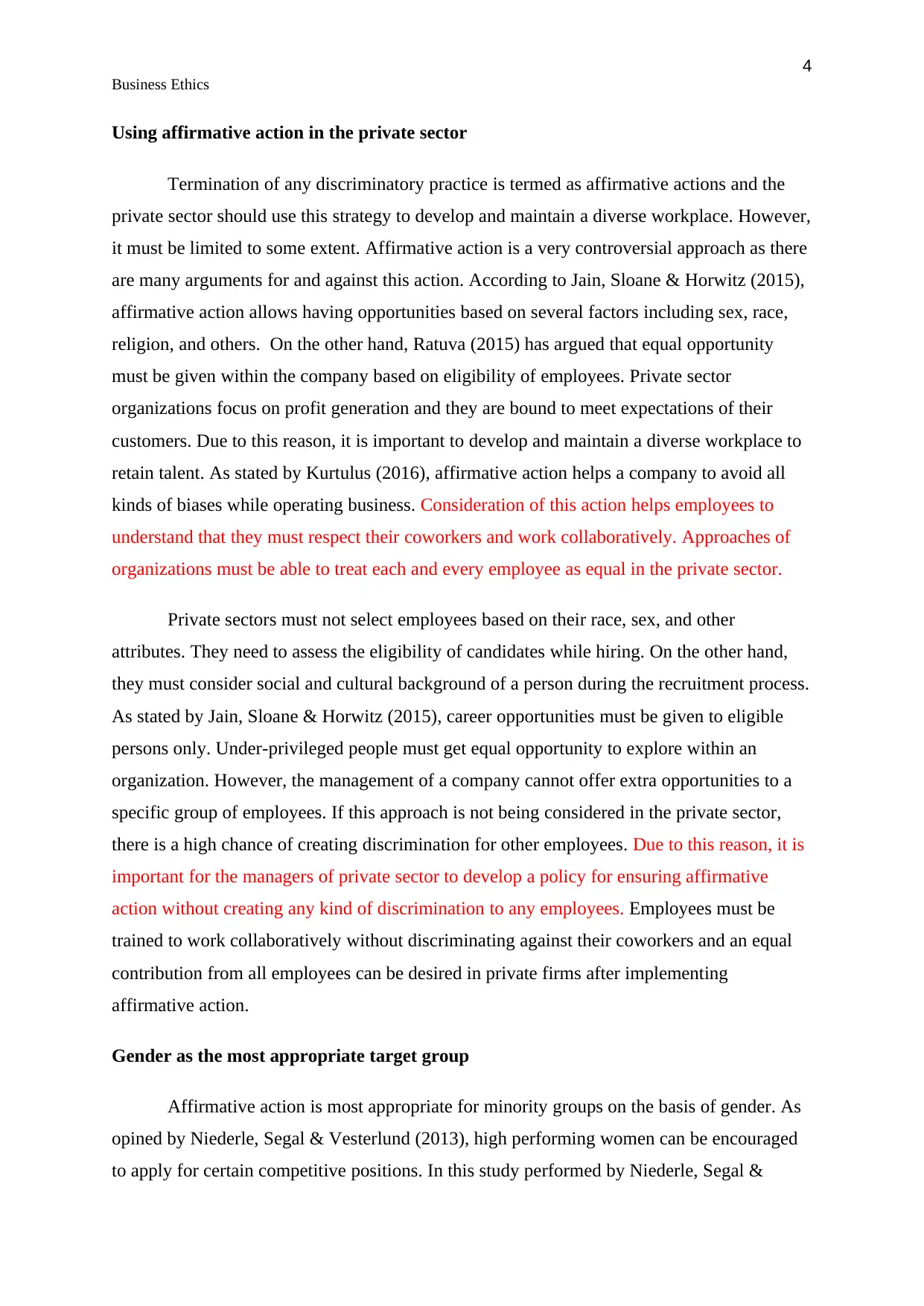
4
Business Ethics
Using affirmative action in the private sector
Termination of any discriminatory practice is termed as affirmative actions and the
private sector should use this strategy to develop and maintain a diverse workplace. However,
it must be limited to some extent. Affirmative action is a very controversial approach as there
are many arguments for and against this action. According to Jain, Sloane & Horwitz (2015),
affirmative action allows having opportunities based on several factors including sex, race,
religion, and others. On the other hand, Ratuva (2015) has argued that equal opportunity
must be given within the company based on eligibility of employees. Private sector
organizations focus on profit generation and they are bound to meet expectations of their
customers. Due to this reason, it is important to develop and maintain a diverse workplace to
retain talent. As stated by Kurtulus (2016), affirmative action helps a company to avoid all
kinds of biases while operating business. Consideration of this action helps employees to
understand that they must respect their coworkers and work collaboratively. Approaches of
organizations must be able to treat each and every employee as equal in the private sector.
Private sectors must not select employees based on their race, sex, and other
attributes. They need to assess the eligibility of candidates while hiring. On the other hand,
they must consider social and cultural background of a person during the recruitment process.
As stated by Jain, Sloane & Horwitz (2015), career opportunities must be given to eligible
persons only. Under-privileged people must get equal opportunity to explore within an
organization. However, the management of a company cannot offer extra opportunities to a
specific group of employees. If this approach is not being considered in the private sector,
there is a high chance of creating discrimination for other employees. Due to this reason, it is
important for the managers of private sector to develop a policy for ensuring affirmative
action without creating any kind of discrimination to any employees. Employees must be
trained to work collaboratively without discriminating against their coworkers and an equal
contribution from all employees can be desired in private firms after implementing
affirmative action.
Gender as the most appropriate target group
Affirmative action is most appropriate for minority groups on the basis of gender. As
opined by Niederle, Segal & Vesterlund (2013), high performing women can be encouraged
to apply for certain competitive positions. In this study performed by Niederle, Segal &
Business Ethics
Using affirmative action in the private sector
Termination of any discriminatory practice is termed as affirmative actions and the
private sector should use this strategy to develop and maintain a diverse workplace. However,
it must be limited to some extent. Affirmative action is a very controversial approach as there
are many arguments for and against this action. According to Jain, Sloane & Horwitz (2015),
affirmative action allows having opportunities based on several factors including sex, race,
religion, and others. On the other hand, Ratuva (2015) has argued that equal opportunity
must be given within the company based on eligibility of employees. Private sector
organizations focus on profit generation and they are bound to meet expectations of their
customers. Due to this reason, it is important to develop and maintain a diverse workplace to
retain talent. As stated by Kurtulus (2016), affirmative action helps a company to avoid all
kinds of biases while operating business. Consideration of this action helps employees to
understand that they must respect their coworkers and work collaboratively. Approaches of
organizations must be able to treat each and every employee as equal in the private sector.
Private sectors must not select employees based on their race, sex, and other
attributes. They need to assess the eligibility of candidates while hiring. On the other hand,
they must consider social and cultural background of a person during the recruitment process.
As stated by Jain, Sloane & Horwitz (2015), career opportunities must be given to eligible
persons only. Under-privileged people must get equal opportunity to explore within an
organization. However, the management of a company cannot offer extra opportunities to a
specific group of employees. If this approach is not being considered in the private sector,
there is a high chance of creating discrimination for other employees. Due to this reason, it is
important for the managers of private sector to develop a policy for ensuring affirmative
action without creating any kind of discrimination to any employees. Employees must be
trained to work collaboratively without discriminating against their coworkers and an equal
contribution from all employees can be desired in private firms after implementing
affirmative action.
Gender as the most appropriate target group
Affirmative action is most appropriate for minority groups on the basis of gender. As
opined by Niederle, Segal & Vesterlund (2013), high performing women can be encouraged
to apply for certain competitive positions. In this study performed by Niederle, Segal &
Paraphrase This Document
Need a fresh take? Get an instant paraphrase of this document with our AI Paraphraser
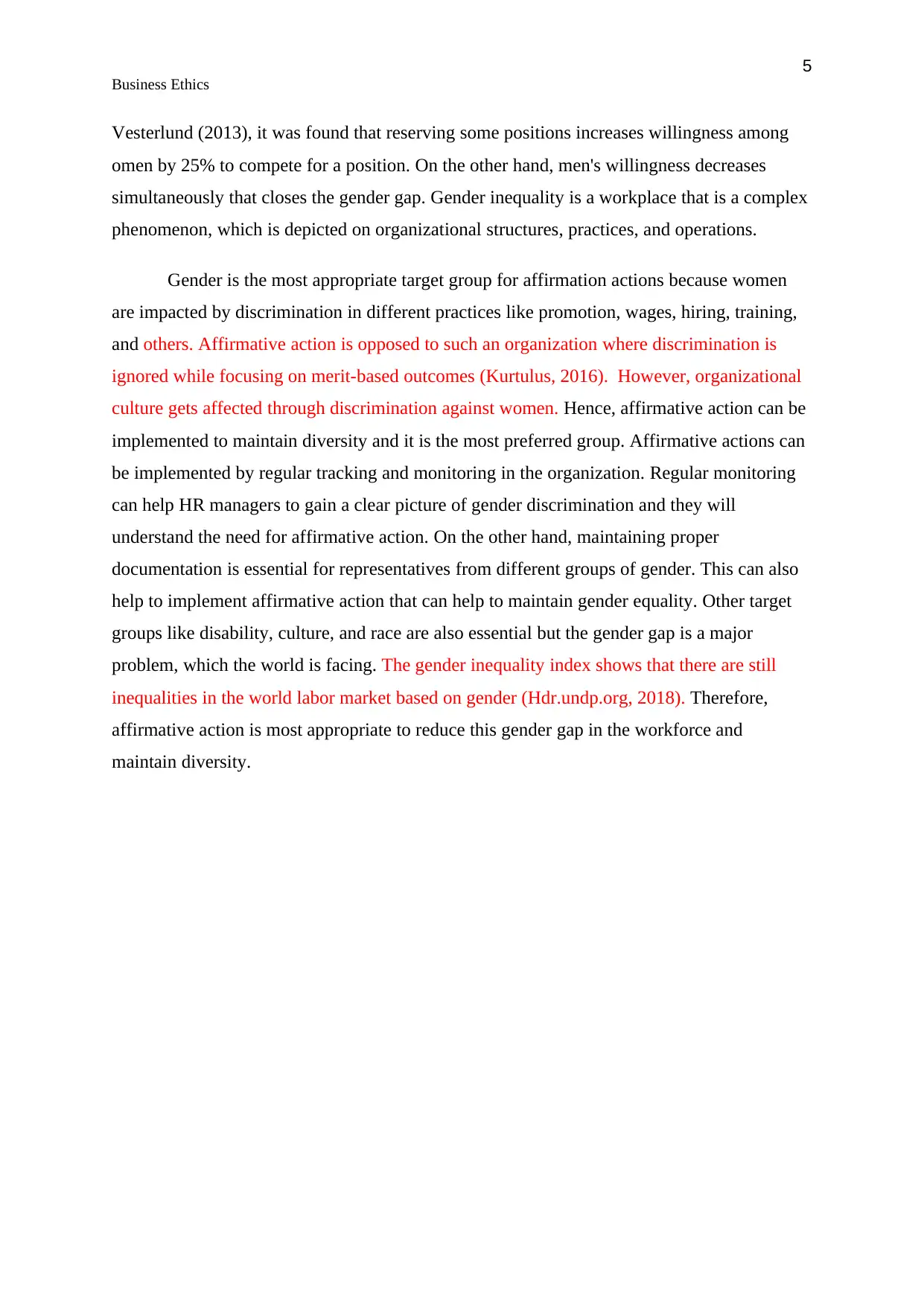
5
Business Ethics
Vesterlund (2013), it was found that reserving some positions increases willingness among
omen by 25% to compete for a position. On the other hand, men's willingness decreases
simultaneously that closes the gender gap. Gender inequality is a workplace that is a complex
phenomenon, which is depicted on organizational structures, practices, and operations.
Gender is the most appropriate target group for affirmation actions because women
are impacted by discrimination in different practices like promotion, wages, hiring, training,
and others. Affirmative action is opposed to such an organization where discrimination is
ignored while focusing on merit-based outcomes (Kurtulus, 2016). However, organizational
culture gets affected through discrimination against women. Hence, affirmative action can be
implemented to maintain diversity and it is the most preferred group. Affirmative actions can
be implemented by regular tracking and monitoring in the organization. Regular monitoring
can help HR managers to gain a clear picture of gender discrimination and they will
understand the need for affirmative action. On the other hand, maintaining proper
documentation is essential for representatives from different groups of gender. This can also
help to implement affirmative action that can help to maintain gender equality. Other target
groups like disability, culture, and race are also essential but the gender gap is a major
problem, which the world is facing. The gender inequality index shows that there are still
inequalities in the world labor market based on gender (Hdr.undp.org, 2018). Therefore,
affirmative action is most appropriate to reduce this gender gap in the workforce and
maintain diversity.
Business Ethics
Vesterlund (2013), it was found that reserving some positions increases willingness among
omen by 25% to compete for a position. On the other hand, men's willingness decreases
simultaneously that closes the gender gap. Gender inequality is a workplace that is a complex
phenomenon, which is depicted on organizational structures, practices, and operations.
Gender is the most appropriate target group for affirmation actions because women
are impacted by discrimination in different practices like promotion, wages, hiring, training,
and others. Affirmative action is opposed to such an organization where discrimination is
ignored while focusing on merit-based outcomes (Kurtulus, 2016). However, organizational
culture gets affected through discrimination against women. Hence, affirmative action can be
implemented to maintain diversity and it is the most preferred group. Affirmative actions can
be implemented by regular tracking and monitoring in the organization. Regular monitoring
can help HR managers to gain a clear picture of gender discrimination and they will
understand the need for affirmative action. On the other hand, maintaining proper
documentation is essential for representatives from different groups of gender. This can also
help to implement affirmative action that can help to maintain gender equality. Other target
groups like disability, culture, and race are also essential but the gender gap is a major
problem, which the world is facing. The gender inequality index shows that there are still
inequalities in the world labor market based on gender (Hdr.undp.org, 2018). Therefore,
affirmative action is most appropriate to reduce this gender gap in the workforce and
maintain diversity.
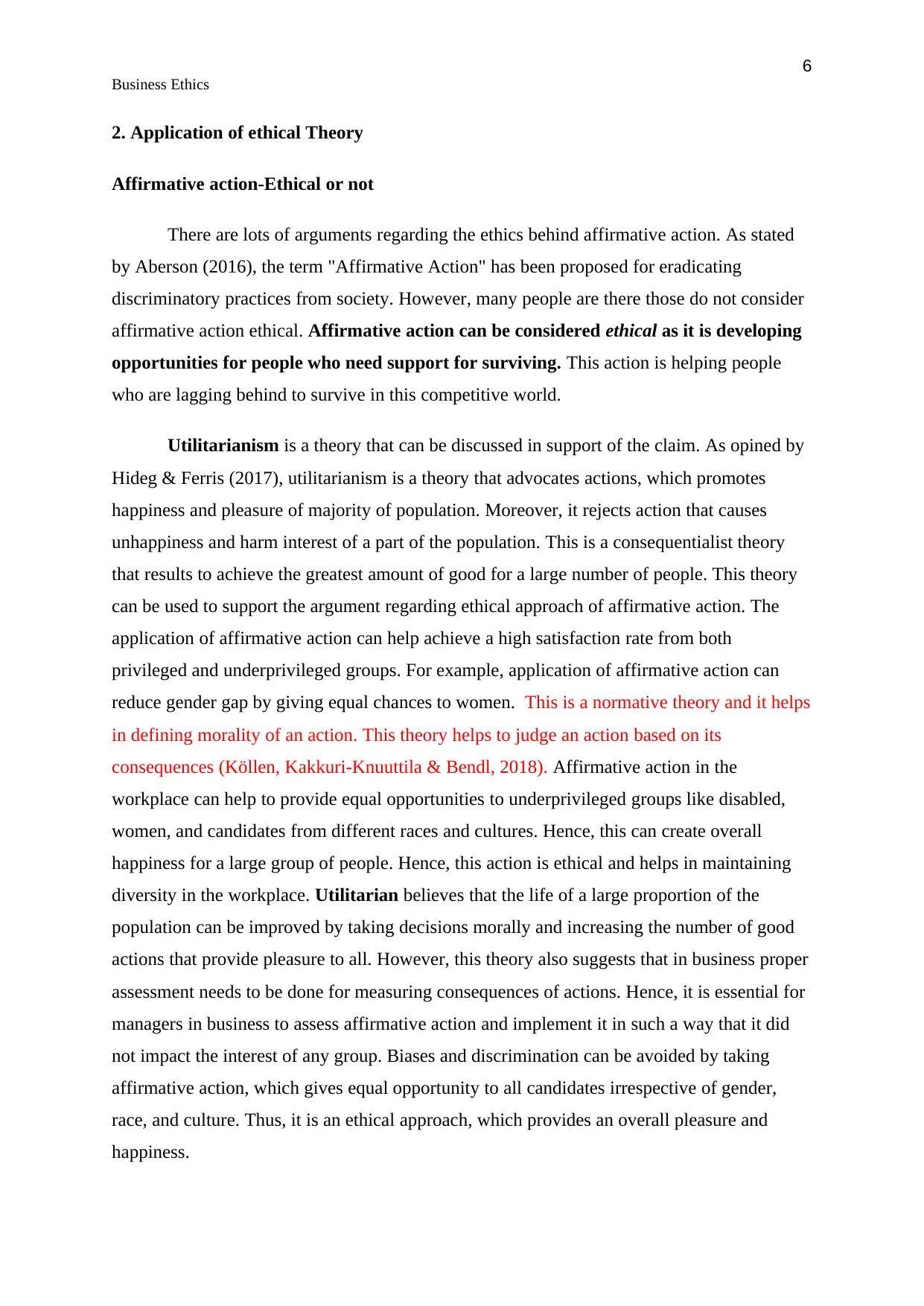
6
Business Ethics
2. Application of ethical Theory
Affirmative action-Ethical or not
There are lots of arguments regarding the ethics behind affirmative action. As stated
by Aberson (2016), the term "Affirmative Action" has been proposed for eradicating
discriminatory practices from society. However, many people are there those do not consider
affirmative action ethical. Affirmative action can be considered ethical as it is developing
opportunities for people who need support for surviving. This action is helping people
who are lagging behind to survive in this competitive world.
Utilitarianism is a theory that can be discussed in support of the claim. As opined by
Hideg & Ferris (2017), utilitarianism is a theory that advocates actions, which promotes
happiness and pleasure of majority of population. Moreover, it rejects action that causes
unhappiness and harm interest of a part of the population. This is a consequentialist theory
that results to achieve the greatest amount of good for a large number of people. This theory
can be used to support the argument regarding ethical approach of affirmative action. The
application of affirmative action can help achieve a high satisfaction rate from both
privileged and underprivileged groups. For example, application of affirmative action can
reduce gender gap by giving equal chances to women. This is a normative theory and it helps
in defining morality of an action. This theory helps to judge an action based on its
consequences (Köllen, Kakkuri-Knuuttila & Bendl, 2018). Affirmative action in the
workplace can help to provide equal opportunities to underprivileged groups like disabled,
women, and candidates from different races and cultures. Hence, this can create overall
happiness for a large group of people. Hence, this action is ethical and helps in maintaining
diversity in the workplace. Utilitarian believes that the life of a large proportion of the
population can be improved by taking decisions morally and increasing the number of good
actions that provide pleasure to all. However, this theory also suggests that in business proper
assessment needs to be done for measuring consequences of actions. Hence, it is essential for
managers in business to assess affirmative action and implement it in such a way that it did
not impact the interest of any group. Biases and discrimination can be avoided by taking
affirmative action, which gives equal opportunity to all candidates irrespective of gender,
race, and culture. Thus, it is an ethical approach, which provides an overall pleasure and
happiness.
Business Ethics
2. Application of ethical Theory
Affirmative action-Ethical or not
There are lots of arguments regarding the ethics behind affirmative action. As stated
by Aberson (2016), the term "Affirmative Action" has been proposed for eradicating
discriminatory practices from society. However, many people are there those do not consider
affirmative action ethical. Affirmative action can be considered ethical as it is developing
opportunities for people who need support for surviving. This action is helping people
who are lagging behind to survive in this competitive world.
Utilitarianism is a theory that can be discussed in support of the claim. As opined by
Hideg & Ferris (2017), utilitarianism is a theory that advocates actions, which promotes
happiness and pleasure of majority of population. Moreover, it rejects action that causes
unhappiness and harm interest of a part of the population. This is a consequentialist theory
that results to achieve the greatest amount of good for a large number of people. This theory
can be used to support the argument regarding ethical approach of affirmative action. The
application of affirmative action can help achieve a high satisfaction rate from both
privileged and underprivileged groups. For example, application of affirmative action can
reduce gender gap by giving equal chances to women. This is a normative theory and it helps
in defining morality of an action. This theory helps to judge an action based on its
consequences (Köllen, Kakkuri-Knuuttila & Bendl, 2018). Affirmative action in the
workplace can help to provide equal opportunities to underprivileged groups like disabled,
women, and candidates from different races and cultures. Hence, this can create overall
happiness for a large group of people. Hence, this action is ethical and helps in maintaining
diversity in the workplace. Utilitarian believes that the life of a large proportion of the
population can be improved by taking decisions morally and increasing the number of good
actions that provide pleasure to all. However, this theory also suggests that in business proper
assessment needs to be done for measuring consequences of actions. Hence, it is essential for
managers in business to assess affirmative action and implement it in such a way that it did
not impact the interest of any group. Biases and discrimination can be avoided by taking
affirmative action, which gives equal opportunity to all candidates irrespective of gender,
race, and culture. Thus, it is an ethical approach, which provides an overall pleasure and
happiness.
⊘ This is a preview!⊘
Do you want full access?
Subscribe today to unlock all pages.

Trusted by 1+ million students worldwide
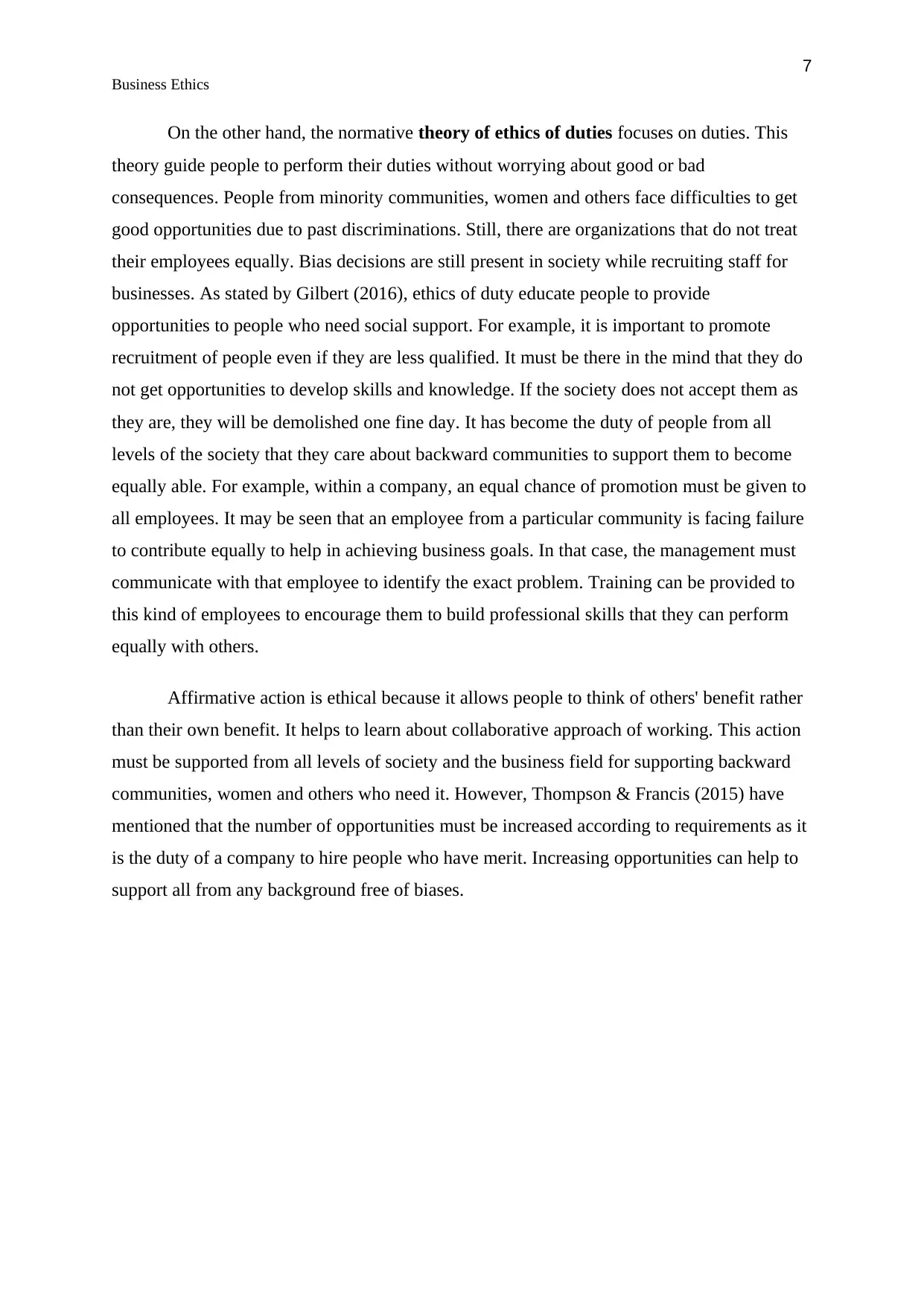
7
Business Ethics
On the other hand, the normative theory of ethics of duties focuses on duties. This
theory guide people to perform their duties without worrying about good or bad
consequences. People from minority communities, women and others face difficulties to get
good opportunities due to past discriminations. Still, there are organizations that do not treat
their employees equally. Bias decisions are still present in society while recruiting staff for
businesses. As stated by Gilbert (2016), ethics of duty educate people to provide
opportunities to people who need social support. For example, it is important to promote
recruitment of people even if they are less qualified. It must be there in the mind that they do
not get opportunities to develop skills and knowledge. If the society does not accept them as
they are, they will be demolished one fine day. It has become the duty of people from all
levels of the society that they care about backward communities to support them to become
equally able. For example, within a company, an equal chance of promotion must be given to
all employees. It may be seen that an employee from a particular community is facing failure
to contribute equally to help in achieving business goals. In that case, the management must
communicate with that employee to identify the exact problem. Training can be provided to
this kind of employees to encourage them to build professional skills that they can perform
equally with others.
Affirmative action is ethical because it allows people to think of others' benefit rather
than their own benefit. It helps to learn about collaborative approach of working. This action
must be supported from all levels of society and the business field for supporting backward
communities, women and others who need it. However, Thompson & Francis (2015) have
mentioned that the number of opportunities must be increased according to requirements as it
is the duty of a company to hire people who have merit. Increasing opportunities can help to
support all from any background free of biases.
Business Ethics
On the other hand, the normative theory of ethics of duties focuses on duties. This
theory guide people to perform their duties without worrying about good or bad
consequences. People from minority communities, women and others face difficulties to get
good opportunities due to past discriminations. Still, there are organizations that do not treat
their employees equally. Bias decisions are still present in society while recruiting staff for
businesses. As stated by Gilbert (2016), ethics of duty educate people to provide
opportunities to people who need social support. For example, it is important to promote
recruitment of people even if they are less qualified. It must be there in the mind that they do
not get opportunities to develop skills and knowledge. If the society does not accept them as
they are, they will be demolished one fine day. It has become the duty of people from all
levels of the society that they care about backward communities to support them to become
equally able. For example, within a company, an equal chance of promotion must be given to
all employees. It may be seen that an employee from a particular community is facing failure
to contribute equally to help in achieving business goals. In that case, the management must
communicate with that employee to identify the exact problem. Training can be provided to
this kind of employees to encourage them to build professional skills that they can perform
equally with others.
Affirmative action is ethical because it allows people to think of others' benefit rather
than their own benefit. It helps to learn about collaborative approach of working. This action
must be supported from all levels of society and the business field for supporting backward
communities, women and others who need it. However, Thompson & Francis (2015) have
mentioned that the number of opportunities must be increased according to requirements as it
is the duty of a company to hire people who have merit. Increasing opportunities can help to
support all from any background free of biases.
Paraphrase This Document
Need a fresh take? Get an instant paraphrase of this document with our AI Paraphraser
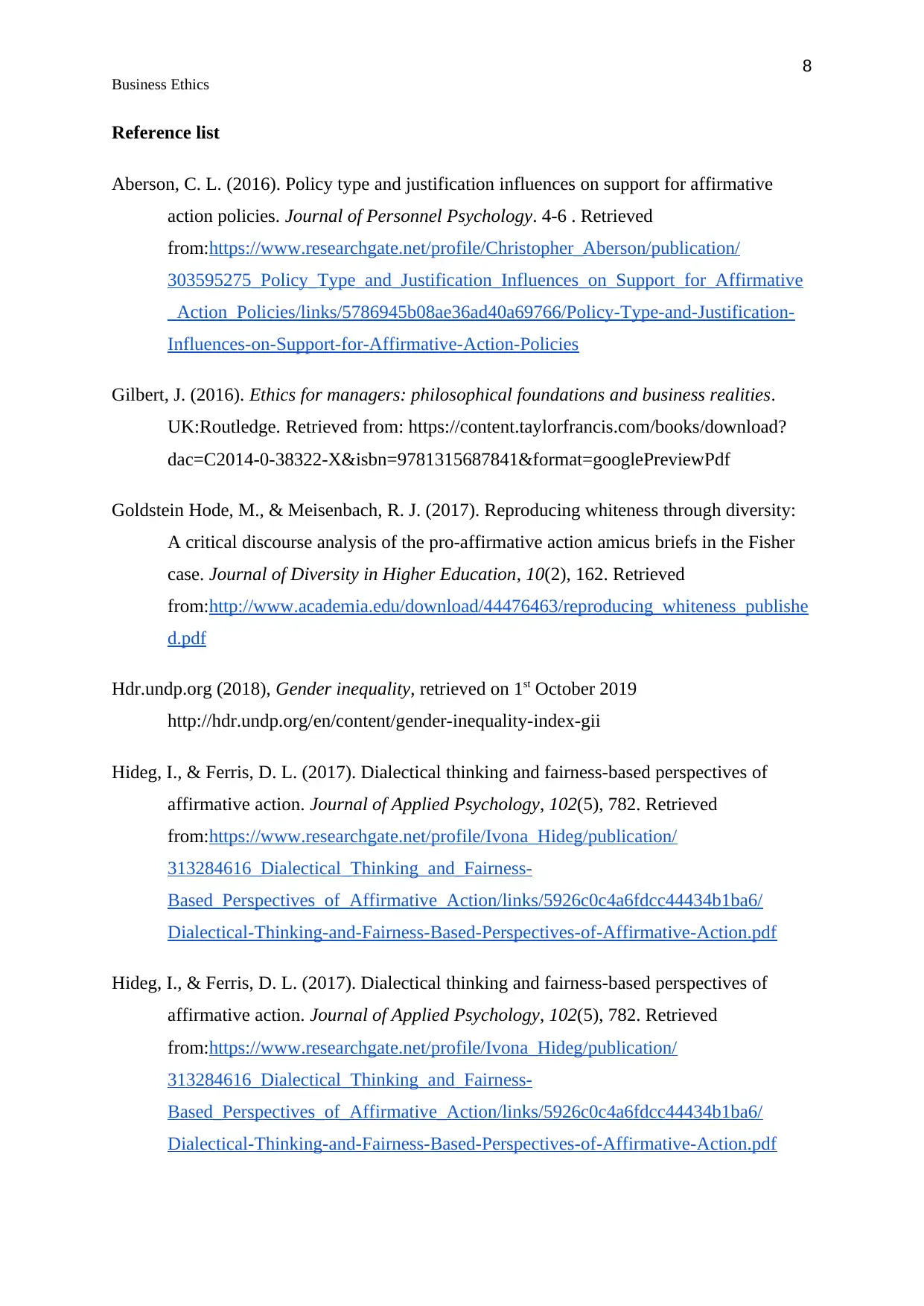
8
Business Ethics
Reference list
Aberson, C. L. (2016). Policy type and justification influences on support for affirmative
action policies. Journal of Personnel Psychology. 4-6 . Retrieved
from:https://www.researchgate.net/profile/Christopher_Aberson/publication/
303595275_Policy_Type_and_Justification_Influences_on_Support_for_Affirmative
_Action_Policies/links/5786945b08ae36ad40a69766/Policy-Type-and-Justification-
Influences-on-Support-for-Affirmative-Action-Policies
Gilbert, J. (2016). Ethics for managers: philosophical foundations and business realities.
UK:Routledge. Retrieved from: https://content.taylorfrancis.com/books/download?
dac=C2014-0-38322-X&isbn=9781315687841&format=googlePreviewPdf
Goldstein Hode, M., & Meisenbach, R. J. (2017). Reproducing whiteness through diversity:
A critical discourse analysis of the pro-affirmative action amicus briefs in the Fisher
case. Journal of Diversity in Higher Education, 10(2), 162. Retrieved
from:http://www.academia.edu/download/44476463/reproducing_whiteness_publishe
d.pdf
Hdr.undp.org (2018), Gender inequality, retrieved on 1st October 2019
http://hdr.undp.org/en/content/gender-inequality-index-gii
Hideg, I., & Ferris, D. L. (2017). Dialectical thinking and fairness-based perspectives of
affirmative action. Journal of Applied Psychology, 102(5), 782. Retrieved
from:https://www.researchgate.net/profile/Ivona_Hideg/publication/
313284616_Dialectical_Thinking_and_Fairness-
Based_Perspectives_of_Affirmative_Action/links/5926c0c4a6fdcc44434b1ba6/
Dialectical-Thinking-and-Fairness-Based-Perspectives-of-Affirmative-Action.pdf
Hideg, I., & Ferris, D. L. (2017). Dialectical thinking and fairness-based perspectives of
affirmative action. Journal of Applied Psychology, 102(5), 782. Retrieved
from:https://www.researchgate.net/profile/Ivona_Hideg/publication/
313284616_Dialectical_Thinking_and_Fairness-
Based_Perspectives_of_Affirmative_Action/links/5926c0c4a6fdcc44434b1ba6/
Dialectical-Thinking-and-Fairness-Based-Perspectives-of-Affirmative-Action.pdf
Business Ethics
Reference list
Aberson, C. L. (2016). Policy type and justification influences on support for affirmative
action policies. Journal of Personnel Psychology. 4-6 . Retrieved
from:https://www.researchgate.net/profile/Christopher_Aberson/publication/
303595275_Policy_Type_and_Justification_Influences_on_Support_for_Affirmative
_Action_Policies/links/5786945b08ae36ad40a69766/Policy-Type-and-Justification-
Influences-on-Support-for-Affirmative-Action-Policies
Gilbert, J. (2016). Ethics for managers: philosophical foundations and business realities.
UK:Routledge. Retrieved from: https://content.taylorfrancis.com/books/download?
dac=C2014-0-38322-X&isbn=9781315687841&format=googlePreviewPdf
Goldstein Hode, M., & Meisenbach, R. J. (2017). Reproducing whiteness through diversity:
A critical discourse analysis of the pro-affirmative action amicus briefs in the Fisher
case. Journal of Diversity in Higher Education, 10(2), 162. Retrieved
from:http://www.academia.edu/download/44476463/reproducing_whiteness_publishe
d.pdf
Hdr.undp.org (2018), Gender inequality, retrieved on 1st October 2019
http://hdr.undp.org/en/content/gender-inequality-index-gii
Hideg, I., & Ferris, D. L. (2017). Dialectical thinking and fairness-based perspectives of
affirmative action. Journal of Applied Psychology, 102(5), 782. Retrieved
from:https://www.researchgate.net/profile/Ivona_Hideg/publication/
313284616_Dialectical_Thinking_and_Fairness-
Based_Perspectives_of_Affirmative_Action/links/5926c0c4a6fdcc44434b1ba6/
Dialectical-Thinking-and-Fairness-Based-Perspectives-of-Affirmative-Action.pdf
Hideg, I., & Ferris, D. L. (2017). Dialectical thinking and fairness-based perspectives of
affirmative action. Journal of Applied Psychology, 102(5), 782. Retrieved
from:https://www.researchgate.net/profile/Ivona_Hideg/publication/
313284616_Dialectical_Thinking_and_Fairness-
Based_Perspectives_of_Affirmative_Action/links/5926c0c4a6fdcc44434b1ba6/
Dialectical-Thinking-and-Fairness-Based-Perspectives-of-Affirmative-Action.pdf
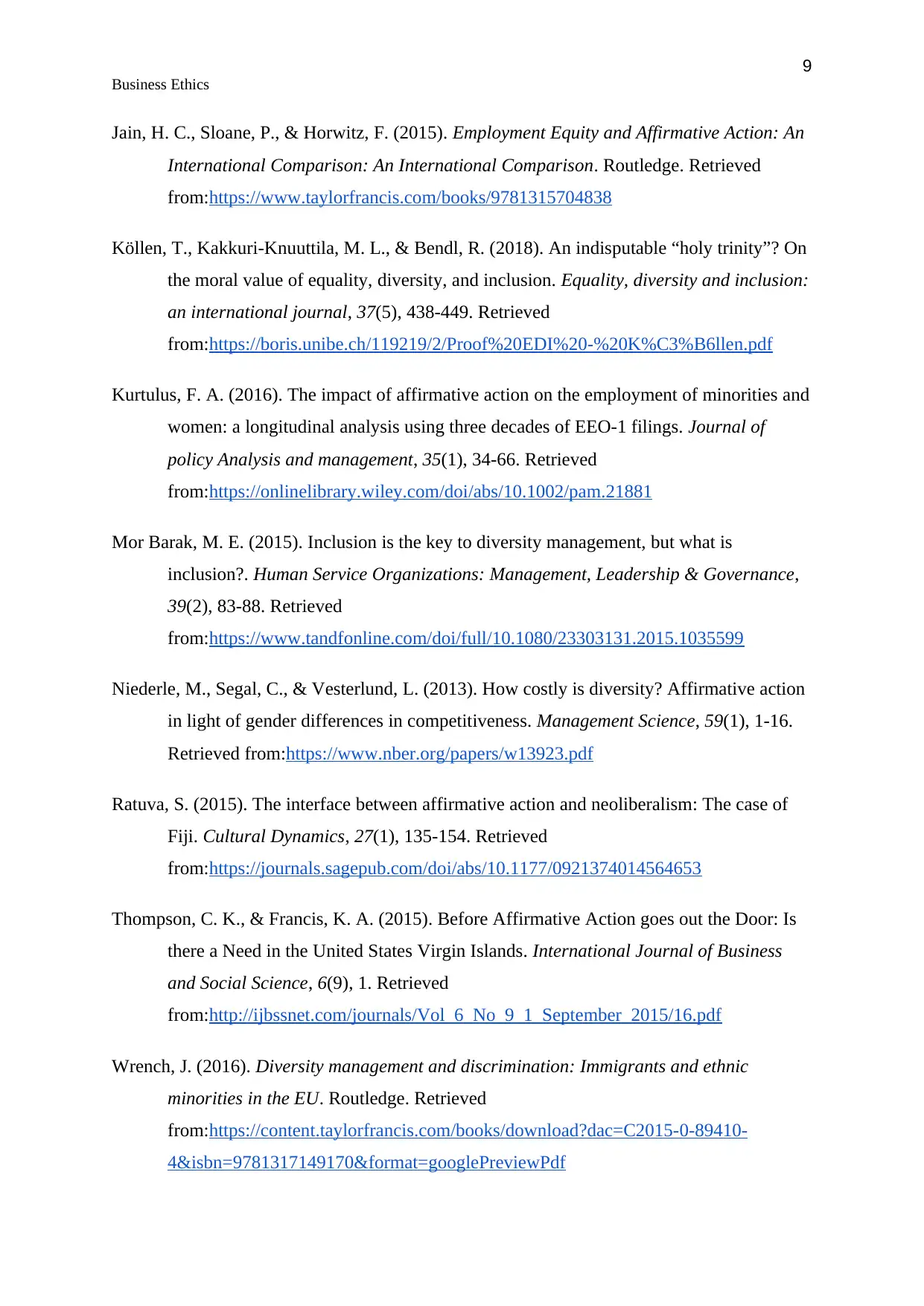
9
Business Ethics
Jain, H. C., Sloane, P., & Horwitz, F. (2015). Employment Equity and Affirmative Action: An
International Comparison: An International Comparison. Routledge. Retrieved
from:https://www.taylorfrancis.com/books/9781315704838
Köllen, T., Kakkuri-Knuuttila, M. L., & Bendl, R. (2018). An indisputable “holy trinity”? On
the moral value of equality, diversity, and inclusion. Equality, diversity and inclusion:
an international journal, 37(5), 438-449. Retrieved
from:https://boris.unibe.ch/119219/2/Proof%20EDI%20-%20K%C3%B6llen.pdf
Kurtulus, F. A. (2016). The impact of affirmative action on the employment of minorities and
women: a longitudinal analysis using three decades of EEO‐1 filings. Journal of
policy Analysis and management, 35(1), 34-66. Retrieved
from:https://onlinelibrary.wiley.com/doi/abs/10.1002/pam.21881
Mor Barak, M. E. (2015). Inclusion is the key to diversity management, but what is
inclusion?. Human Service Organizations: Management, Leadership & Governance,
39(2), 83-88. Retrieved
from:https://www.tandfonline.com/doi/full/10.1080/23303131.2015.1035599
Niederle, M., Segal, C., & Vesterlund, L. (2013). How costly is diversity? Affirmative action
in light of gender differences in competitiveness. Management Science, 59(1), 1-16.
Retrieved from:https://www.nber.org/papers/w13923.pdf
Ratuva, S. (2015). The interface between affirmative action and neoliberalism: The case of
Fiji. Cultural Dynamics, 27(1), 135-154. Retrieved
from:https://journals.sagepub.com/doi/abs/10.1177/0921374014564653
Thompson, C. K., & Francis, K. A. (2015). Before Affirmative Action goes out the Door: Is
there a Need in the United States Virgin Islands. International Journal of Business
and Social Science, 6(9), 1. Retrieved
from:http://ijbssnet.com/journals/Vol_6_No_9_1_September_2015/16.pdf
Wrench, J. (2016). Diversity management and discrimination: Immigrants and ethnic
minorities in the EU. Routledge. Retrieved
from:https://content.taylorfrancis.com/books/download?dac=C2015-0-89410-
4&isbn=9781317149170&format=googlePreviewPdf
Business Ethics
Jain, H. C., Sloane, P., & Horwitz, F. (2015). Employment Equity and Affirmative Action: An
International Comparison: An International Comparison. Routledge. Retrieved
from:https://www.taylorfrancis.com/books/9781315704838
Köllen, T., Kakkuri-Knuuttila, M. L., & Bendl, R. (2018). An indisputable “holy trinity”? On
the moral value of equality, diversity, and inclusion. Equality, diversity and inclusion:
an international journal, 37(5), 438-449. Retrieved
from:https://boris.unibe.ch/119219/2/Proof%20EDI%20-%20K%C3%B6llen.pdf
Kurtulus, F. A. (2016). The impact of affirmative action on the employment of minorities and
women: a longitudinal analysis using three decades of EEO‐1 filings. Journal of
policy Analysis and management, 35(1), 34-66. Retrieved
from:https://onlinelibrary.wiley.com/doi/abs/10.1002/pam.21881
Mor Barak, M. E. (2015). Inclusion is the key to diversity management, but what is
inclusion?. Human Service Organizations: Management, Leadership & Governance,
39(2), 83-88. Retrieved
from:https://www.tandfonline.com/doi/full/10.1080/23303131.2015.1035599
Niederle, M., Segal, C., & Vesterlund, L. (2013). How costly is diversity? Affirmative action
in light of gender differences in competitiveness. Management Science, 59(1), 1-16.
Retrieved from:https://www.nber.org/papers/w13923.pdf
Ratuva, S. (2015). The interface between affirmative action and neoliberalism: The case of
Fiji. Cultural Dynamics, 27(1), 135-154. Retrieved
from:https://journals.sagepub.com/doi/abs/10.1177/0921374014564653
Thompson, C. K., & Francis, K. A. (2015). Before Affirmative Action goes out the Door: Is
there a Need in the United States Virgin Islands. International Journal of Business
and Social Science, 6(9), 1. Retrieved
from:http://ijbssnet.com/journals/Vol_6_No_9_1_September_2015/16.pdf
Wrench, J. (2016). Diversity management and discrimination: Immigrants and ethnic
minorities in the EU. Routledge. Retrieved
from:https://content.taylorfrancis.com/books/download?dac=C2015-0-89410-
4&isbn=9781317149170&format=googlePreviewPdf
⊘ This is a preview!⊘
Do you want full access?
Subscribe today to unlock all pages.

Trusted by 1+ million students worldwide

10
Business Ethics
Business Ethics
1 out of 10
Related Documents
Your All-in-One AI-Powered Toolkit for Academic Success.
+13062052269
info@desklib.com
Available 24*7 on WhatsApp / Email
![[object Object]](/_next/static/media/star-bottom.7253800d.svg)
Unlock your academic potential
Copyright © 2020–2025 A2Z Services. All Rights Reserved. Developed and managed by ZUCOL.





